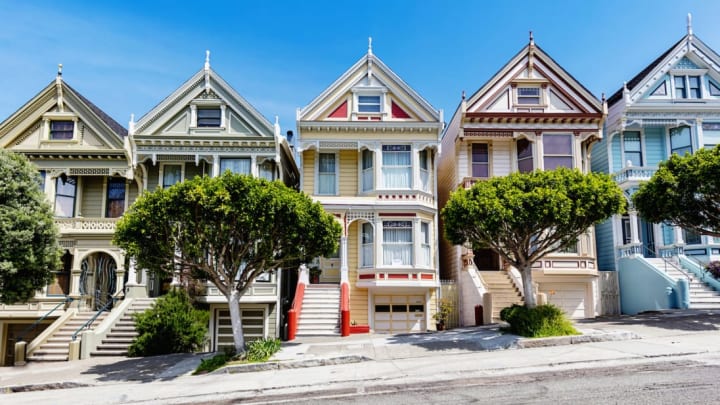From the totally charming to the truly bizarre, older houses feature tons of tiny details that you'd never find in a brand-new construction. If you're house hunting for an oldie-but-goodie, here are 10 quirky things you might find.
1. MOTHER-IN-LAW BED
Unlike a Murphy bed, which cranks out of the wall, a mother-in-law bed cranks out of the ceiling.
2. DUMBWAITERS

Any little kid who read Harriet the Spy when they were young wanted a dumbwaiter in their house. Despite what Harriet used it for (spying, of course), dumbwaiters were not meant to carry people; they were most often used as kitchen help, to carry dishes and things when the kitchen and dining room were on different levels of the house. They're still utilized in some restaurants today, and a more modern version can be found in libraries and large office buildings to ferry large amounts of books and files from floor to floor.
3. BUILT-IN BEEHIVES
Don't call an exterminator: built-in beehives are supposed to be there. These were actually installed on purpose for the convenience of the beekeeping homeowner. Pipes go through the walls and behind the walls were beehives. The bees could move about freely through the pipes and make honey. When someone in the kitchen downstairs wanted honey, they simply trekked up the stairs, removed the back of the hive, and grabbed what they needed.
4. COAL CHUTES

Though few people use coal as a heating source these days, many older homes still feature coal chutes: typically, there's a big iron door visible on the outside of the house where shipments of coal would be shoveled in.
5. PHONE NICHE
Not so long ago, landlines were essential to communication—and they weren't the tiny, non-intrusive devices we know today. They were big, heavy, cumbersome things that took up a fair amount of space. To try to keep phones off of countertops and out of the way, home builders started making niches in walls. It seems as though a lot of people are repurposing the niches these days as a place to store mail or perch a plant or two. Boing Boing found one (it was built for Jean Harlow) and thought perhaps it was a place to store champagne or milk bottles; it was later concluded that the spot used to be a phone niche and was divided into a place to vertically store mail once the phone was no longer needed there.
6. SERVANT STAIRCASES

In old mansions that required a large household staff to keep them running, servants were expected to stay out of sight. After all, you wouldn't want your well-heeled guests running into the maid on the staircase, would you? How gauche. The solution was a separate staircase in the back just for servant use. If you've ever run across a kitchen or pantry that could be accessed by two staircases and wondered what on earth the purpose was, now you know.
7. BUTLER'S PANTRY

How nice would it be to have a giant pantry separate from your kitchen? Old houses often have these tiny kitchens, which make a great place for storing your food. But that wasn't always their purpose; some just contained extra counter space and sinks so that servants could do their thing out of sight. In Europe, the silver was often kept in the butler's pantry and the butler would actually sleep in there to guard the silver.
8. COLD CLOSETS
Don't let the name mislead you: a cold closet is not the same thing as an icebox. An icebox was a free-standing piece of furniture that held a big block of ice near the top to keep the contents frozen. (Icemen delivered new blocks of ice every day, just like the milkman.) A cold closet, on the other hand, was built into the house and couldn't actually keep things frozen, just cool. So while you could keep your veggies and cheese and meats cool, stocking ice cream in the cold closet would be a bad idea.
9. MILK DOORS

It's been a while since any of us had milk delivered to our back doors, but back when that was the norm, a milk door was standard with a lot of houses. The milkman would open a tiny door on the side of the house, usually right next to the main door, and basically leave the milk in between the walls. Then the homeowners could open the door on their side and remove the bottles. Voila! Fresh milk to go with your breakfast.
10. ROOT CELLARS

Just like in The Wizard of Oz, you have to go outside to access a root cellar—and it was the first place you'd go if you saw a twister off in the distance. As the name suggests, it was used to store veggies for long periods of time, particularly over the winter.
